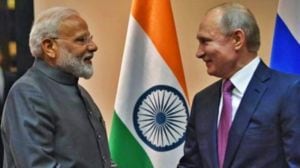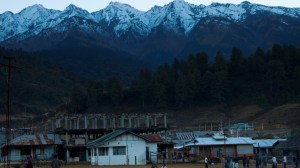Rs 32 and an invisible line
Khatoons family in Delhi is officially the poorest of the poor and has an Antyodaya Anna Yojana card. With the debate over the Planning Commission affidavit in the Supreme Court,a look at her household budget
Thirteen is an awkward number in Waseema Khatoons household. That means that even if we buy a dozen eggs,it wont be enough for all of us, she says,smiling.
Its not just the number of members in her family that is stopping Khatoon from buying eggs. The family buys them so rarely,the lady of the house isnt very sure how much they cost: I think they are going at Rs 4 an egg. We use them in curry,and that too,once a month or so.
Khatoon,her husband Mohammad Shareef and their 10 children and one grandchild live in Sunlight Colony in the Old Seemapuri area of Delhi,a family of 13. At a time when the Planning Commission has indicated that spending more than
Rs 965 a month on a city-based individual will keep you above the poverty line,this household lives on the Rs 6,000 that the second daughter brings home every month by working at a mall.
Umaira buys most of the groceries together,after she gets her salary. She has to take care of her conveyance,which costs her Rs 15,up and down,by bus, says Khatoon. Six of her nine girls and the lone boy are enrolled in the neighbouring school.
The Dilshad Garden Metro station is barely two kilometres away. Most of us dont use the Metro. Its comfortable,but we usually travel to interior areas. That means getting off the Metro and then spending on another mode of travel. In Umairas case,she has to change over to the Yellow Line,and then to the Blue Line before she can reach the mall, says Azra,24,the eldest,and the mother of three-year-old Ikra.
We got her married,but instead of one member less,we now have to take care of one more, says Khatoon,patting three-year-old Ikra,sitting on her lap. Azras husband is a labourer in Surat and he cannot afford to have his wife and child living with him. In fact,he cannot even afford to send them a monthly allowance.
August was a cruel month. Ikra broke her left hand, says Azra,extending her daughters hand gingerly. I rushed her to a nearby private clinic. They charged Rs 300,and told me that they would have to break her bones again to set them right. I got scared, she says. Azra had to rush Ikra to a different nursing homea trip that cost her 20 rupees each sideand get the hand plastered for Rs 1,500. There was also an additional charge of Rs 160 for an X-Ray.
The family has learnt to cope with medical emergencies. One of the nine daughters has a kidney stone,so they have abandoned tomatoes altogether,and hopes the stone will go away. We bought two kilos of potato for Rs 12 a kilo two days back,and that should do for another day, says Khatoon.
Vegetables and milk are bought on a need-to-buy basis. Nobody drinks milk here. It all goes into making chai. I buy a litre for Rs 27 everyday, says Shareef,Khatoons husband. The last job he held was three months ago,a porter at the Anand Vihar Railway Station.
The family is officially the poorest of the poor and has an Antyodaya Anna Yojana card. They get 10 litres of kerosene at Rs 15 a litre,25 kilogrammes of wheat at Rs 2 a kg,10 kilogrammes of rice at Rs 3 a kg and six kilogrammes of sugar at Rs 13.5 a kg every month with the card.
However,when the scheme began in 2002,they never got what they were entitled to. The ration shop went on charging us market rates for whatever they gave us. Most of the time,we did not get much. The maximum quantity of sugar I got with my AAY card was three kilogrammes in a month, says Khatoon. The women of the locality got together and filed an application under the Right to Information Act,which revealed how much they were entitled to with their ration cards.
Kerosene is a worry. We used to get 11 litres for Rs 142 till recently. Now,there are rumours that even this will stop. They plan to give us some money in hand and ask us to get gas cylinders, says Azra,referring to the proposed cash-transfer scheme,where the government will hand over the money it provides as fuel subsidy to the household,expecting them to chip in the rest.
These are their rates. The government fixes the price of petrol,gas and milk,and tells us to live on Rs 32 a day, says Khatoon.
Except for urad dal,of which the family consumes two kilos monthly,the family consumes four kilos each of three varieties of pulses. They also buy seven litres of oil five of mustard and two of refinedat about Rs 80 a litre. They need 30 kilos of atta (Loose,we cannot afford to buy the ones in packets, says Khatoon) at the rate of Rs 16 a kg. Besides,the family has to buy rice and wheat from the open market,as the quantity they get from the ration shop is never enough.
August was a cruel month,also because of Ramzan. I spent almost
Rs 500 every day on fruits,shikanji and food. We also donated quite a bit. We didnt buy any mutton,thoughit costs Rs 280 a kg. Eid is also when the family makes its annual purchase of clothes. We buy 14 pairs every year. Each suit (salwar) costs about Rs 250. Thankfully,there are only two men; their dresses cost at least Rs 500 each, says Azra. The extra three kilos of sugar that the government gifts for Ramzan has still not arrivedthe ration shop,which opens only once monthly,has still not opened for the month.
The problem with Ramzan is that the happier we are,the more we give. This year,we were quite happy, says Azra.


- 01
- 02
- 03
- 04
- 05





























